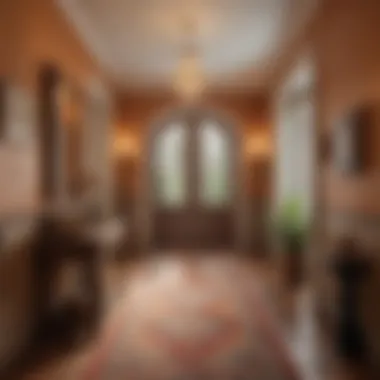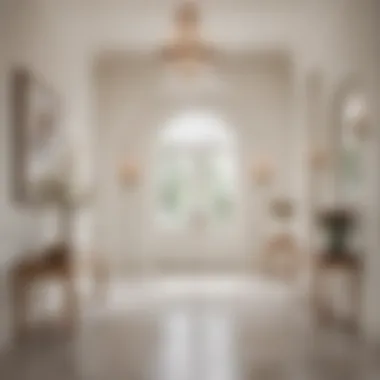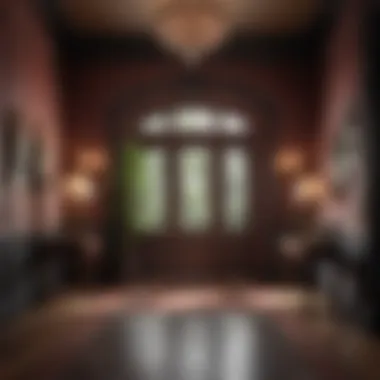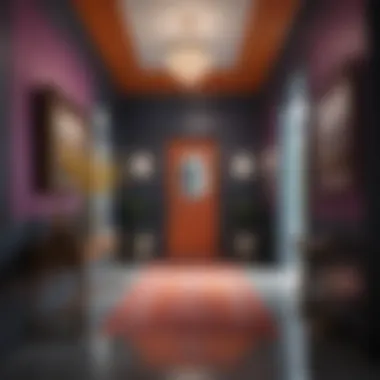Entryway Paint Color Ideas for a Stunning First Impression


Intro
The entryway serves as the threshold to one’s home. It is the area that sets the tone for a visitor's experience. Therefore, selecting the right paint color for this essential space can significantly affect both ambiance and perception. Color is not just an aesthetic decision; it also bears emotional and psychological weight. This article delves into a variety of paint color ideas, examining how they can transform an entryway into a welcoming, inviting environment.
In this exploration, we will consider various color palettes and their psychological ramifications, ensuring a dual focus on design and mood. Additionally, practical strategies for choosing the ideal hue will be outlined, allowing homeowners to create an entryway that resonates with style and warmth.
We will also explore contemporary trends in interior design and discuss how they influence paint color choices.
Outdoor Decor Ideas
Creating a captivating first impression goes beyond the interior. The exterior of a home, particularly the entryway, plays an essential role in priming that impression. Distinctive outdoor decor can enhance the allure of an entryway. The following aspects are crucial for developing an inviting outdoor space:
- Seasonal Inspirations: Different seasons offer unique hues. Spring allows for fresh pastels, while autumn showcases rich earth tones. Adjusting the entry color scheme with the seasons can keep the facade feeling vibrant and refreshed.
- Furniture Selection: Choosing the right outdoor furniture, such as benches or stylish chairs, can define the character of the space. Colors in these items need to complement the paint chosen for optimal harmony.
- Decorative Lighting: The role of lighting cannot be understated. Warm-toned lights not only illuminate but also enhance the warmth of the colors on the walls. Thoughtfully placed fixtures create ambiance even after sunset.
- Plant Arrangements: Greenery can provide contrast and vibrancy. Consider how flowering plants or low-maintenance succulents bring life. Selecting plant colors that enhance the paint hue can establish a cohesive look.
- Hardscaping Solutions: Pathways and stones should align with the overall color theme. Paying attention to earthy colors in materials lends depth to the design.
- Sustainable Practices: Opt for eco-friendly paints and materials. This not only supports the environment but also reflects a polished, conscientious homeowner appearance.
"An inviting entryway is a physical manifestation of the values and warmth of the home within."
In summary, the choice of outdoor decor plays a large role in establishing the overall vibe of an entryway, complementing the colors chosen for the walls. Creating a space that feels both alive and welcoming is paramount in the design process.
As we move through this article, it will be essential to explore the mathematical concepts of color theory and apply it practically to paint choices. This will empower homeowners to navigate their choices effectively, ensuring they achieve the desired emotional resonance in their entryways.
Understanding the Role of Entryway Colors
The entryway of a home serves as the initial interface between the interior and the outside world. It is a space where first impressions are formed, and therefore, the role of color in this area cannot be overstated. Entryway colors set the tone for the entire home. A carefully chosen palette can evoke warmth, sophistication, or tranquility, influencing how visitors perceive the space.
When selecting a paint color for an entryway, it is essential to consider the emotions that colors can provoke. Different colors communicate different messages. For instance, warm hues like red or orange convey energy and hospitality, while cooler shades such as blue and green exude calmness.
Utilizing color effectively in an entryway enhances the overall aesthetic of the home. A well-coordinated color scheme can harmonize with decor elements, creating an inviting atmosphere. This is paramount for anyone who desires to leave an enduring mark on their guests. A well-considered paint choice can lead to a sense of welcome that lingers long after a visitor has departed.
In addition to aesthetics, entryway colors can provide functional benefits. Lighter shades can make a small space appear larger and more open, while darker tones can add a sense of depth and intimacy. Color choices can also highlight architectural features, guiding the eye and adding to the character of the space.
The Significance of First Impressions
First impressions often occur within mere seconds. Studies indicate that people form opinions about a space based on visual cues almost instantly. The entryway is the first part of the home that a visitor sees, making its color choice critical. A carefully selected color can create a welcoming and appealing entrance, setting positive expectations for the rest of the home.
Key Points:
- Color influences perception and emotional response.
- A well-chosen palette can enhance the architectural features of the entryway.
- First impressions are quickly formed and can be lasting.
Color Psychology and Entryways
Understanding color psychology is essential when selecting entryway hues. Colors can evoke certain feelings and associations, significantly impacting how one feels upon entering a space. For example, shades of blue are often associated with calm and tranquility, making them ideal for creating a serene entryway.
On the contrary, vibrant and saturated colors can stimulate excitement and positive energy. Consider using bold colors for the entryway if the intent is to energize and uplift.
Color Associations:
- Blue: Calmness and peace.
- Red: Energy and passion.
- Green: Renewal and nature.
- Yellow: Happiness and cheer.


While color preferences vary, the psychological impacts remain consistent across different audiences. Thus, understanding these effects can aid in making informed choices that resonate with both personal style and the desired mood for the entryway. Taking the time to comprehend these nuances in color psychology will undoubtedly contribute to creating an inviting atmosphere that appeals to all who enter.
Neutral Color Schemes
Neutral colors often serve as the backbone of any elegant design. They provide a versatile backdrop that complements various decor styles, making them a popular choice for entryways. These hues can invoke a feeling of calm yet sophisticated ambiance, setting the tone for the rest of the home. By utilizing neutral color schemes, homeowners can create a space that is both welcoming and understated, allowing other design elements to pop.
Classic Whites and Off-Whites
Classic whites and off-whites are timeless entryway choices. These shades reflect light. Thus, they can make a small space appear larger. Soft whites create a clean and fresh atmosphere, evoking feelings of serenity. Off-white tones, such as creamy or ivory, add warmth without overwhelming the senses. This warmth helps guests feel at ease as soon as they enter.
Consider pairing these colors with darker furniture or colorful accessories. This contrast can enhance the overall aesthetic. Additionally, maintaining a minimalist decor with flowers or elegant mirrors can elevate the space’s gracefulness. Overall, whites and off-whites can work in any setting.
Greys for Modern Elegance
Grey tones have become a staple in modern interior design. They bring a sense of sophistication without the harshness of darker colors. Light greys can contribute to a calm and airy vibe, while darker shades add depth. Grey allows for flexibility in accessorizing with various colors. It can pair perfectly with bold hues like deep navy or muted pastels.
When implementing greys in an entryway, it is crucial to consider the lighting. Natural light can drastically alter how grey appears. A south-facing entryway might benefit from cooler greys, while a north-facing one may warrant warmer tones.
More important, combining greys with textures can enhance the inviting nature of the space. Soft rugs, unique art pieces, or even metallic accents help elevate the overall charm of a grey entryway.
Beige and Taupe for Warmth
Beige and taupe are excellent choices for those wanting a warm and inviting atmosphere. Both colors possess earth-toned qualities that can make a home feel approachable. Beige, with its yellow undertones, provides warmth and is incredibly adaptable with various color schemes. Taupe brings a slightly more sophisticated touch. It often has hints of grey, giving it an elegant finish.
Enhancing a beige or taupe entryway can be achieved with wood accents. Natural materials such as rattan or wicker can add texture and create an inviting contrast. Incorporating art or books that match the warmth of these colors helps create a cohesive look.
In summary, neutral color schemes hold significant value in entryway design. They lay the foundation for a warm and inviting space that smoothly transitions into the rest of the home's interiors. Choosing between whites, greys, or warm earthy tones allows for personal expression while ensuring a timeless appeal.
Bold and Dark Color Choices
Choosing bold and dark colors for entryway paint can leave a powerful impression. Unlike lighter shades, which often feel airy or open, darker colors impart a sense of drama and sophistication. These tones can evoke strong emotions and set a distinct mood. When selecting a dark hue, it's essential to consider the impact these colors will have on the overall atmosphere of the entryway. It's important to balance elegance with warmth. If executed properly, dark colors can transform a mundane space into a grand introduction to your home.
Deep Blues for Serenity
Deep blue can create an atmosphere of calm and serenity. This color promotes relaxation and peace, making your entryway feel more inviting. Navy or midnight blues can evoke the tranquility of the ocean or a clear night sky. These hues work well when paired with natural materials like wood or stone. Choosing these shades may encourage visitors to feel at ease from the moment they step through the door.
Charcoal and Black for Drama
Charcoal and black paint can make a striking statement in an entryway. These shades bring a sense of elegance and depth. A charcoal wall can serve as a striking backdrop for light-colored furnishings or decorative elements. Black, while bold, works its best when balanced with strategically placed lighting or accents. This combination creates a dramatic entrance that can surprise and engage guests.
Dark Green for a Natural Touch
Dark green adds a touch of nature inside the home. This color can mimic the rich tones of a forest. It suggests growth and peace, grounding your entryway while providing a refreshing backdrop. Dark green works particularly well in homes surrounded by nature or with botanical elements in the decor. It can create a welcoming and cozy atmosphere that reflects an appreciation for the outdoors.
"The use of bold and dark colors in interior design not only influences aesthetics but also communicates a deeper narrative about personal style and preferences."
When considering bold and dark color choices, it is crucial to factor in lighting, both natural and artificial. Dark colors absorb light, potentially making a small space feel more confined. It's advisable to use lighter accents or strategic lighting solutions to counterbalance this effect. An effective mix of colors and lighting can ensure the entryway remains inviting.


Pastel Color Environments
Pastel colors play a significant role in creating welcoming atmospheres within entryways. These shades are known for their soft, muted tones that can evoke feelings of tranquility and warmth. Using pastels in the entryway can gently ease guests into your home, setting a comforting tone right from the start. Pastel colors also have the unique ability to reflect light, allowing smaller or dimly lit spaces to appear larger and more inviting.
When selecting a pastel palette, it is essential to consider how these colors interact with natural and artificial light. Light, for instance, can enhance the subtle distinctions of pastel shades, creating a dynamic environment that changes throughout the day. This quality makes pastels versatile, as they can adapt to various lighting conditions, ensuring the entryway remains inviting at any time.
Soft Pink for Inviting Space
Soft pink is a color that embodies warmth and approachability. When applied to an entryway, it creates an inviting focal point that can make guests feel at home. This hue pairs well with both light and dark furnishings, making it adaptable for different decor styles.
Incorporating soft pink can also benefit mental well-being. Studies suggest that soft pink tones can reduce anxiety and promote a sense of calm. Thus, this color can be particularly effective in entryways where people might feel rushed or anxious upon arriving.
Lavender for Calmness
Lavender is another pastel color that enhances a sense of peace and tranquility. Its gentle hue creates a serene backdrop, establishing an immediate sense of calm as soon as one enters the home. Lavender works beautifully with white or cream accents, drawing attention to any architectural features without overwhelming them.
This color also evokes feelings of nostalgia and elegance, making it suitable for both modern and traditionally styled entryways. Its versatility allows it to be combined with other pastels for a cohesive design or used alone for a statement look.
Mint Green for Freshness
Mint green stands out as a color that signifies freshness and vitality. When applied to entryways, it creates an uplifting and rejuvenating environment. Mint acts as a breath of fresh air, particularly beneficial in urban settings or gloomy climates.
Furthermore, mint green can also enhance the natural light in a space, making it appear more expansive. When matched with natural wood tones or white trim, it infuses the entryway with a refreshing charm that encourages a sense of connection with nature.
The choice of pastel colors can transform an entryway into an inviting space that reflects one's personal style while ensuring a warm welcome for all who enter.
Eclectic and Unique Color Combinations
When considering entryway paint colors, eclectic and unique combinations stand out as a daring approach that can leave a lasting impression. This section is essential as it emphasizes the individuality of one’s space. While traditional color schemes are popular, mixing and matching colors can redefine and elevate the ambiance of an entryway. Such combinations allow for personal expression, reflecting the homeowner’s style and creativity.
Choosing an eclectic palette can dramatically transform the character of an entryway. Here are some benefits and considerations:
- Personal Touch: Unique color combinations allow for individuality, making the entryway a true reflection of the homeowner's personality.
- Visual Interest: Mixing colors can create a dynamic look that captures attention and communicates warmth, creativity, or even sophistication.
- Theme Versatility: Different colors can be combined to align with various interior design themes, from modern to rustic.
However, it’s important to keep balance in mind. Too many contrasting colors can overwhelm visitors. Using a few harmonious shades along with contrasting accents can create a well-rounded aesthetic.
Contrasting Colors for Impact
Contrasting colors can significantly amplify the entryway’s visual effect. They create striking spaces that catch the eye immediately upon entering. When selecting contrast pairs, consider color theory basics; complementary colors can play off each other well. For example, a deep navy can beautifully contrast with a bright mustard yellow. This setup not only grabs attention, but it also instills energy.
Balancing contrasting colors in an entryway involves:
- Strategic Placement: Place bold hues on doors or accessories while keeping the larger wall surfaces more neutral to maintain a sense of space.
- Cohesion with Decor: Make sure that contrasting colors resonate with the rest of the home, pulling elements together for a singular aesthetic.
"Using contrasting colors wisely can enhance the depth of the entryway, inviting a sense of drama and allure to the first impression of the home."
Accent Walls in Entryways


Accent walls serve as a creative technique to add depth and interest to entryways. This approach involves painting one wall a bold hue while keeping the others neutral. It serves to highlight a specific area, such as behind a console table or artwork. This can draw the eye and enhance the overall dynamics of the space.
When planning for an accent wall, these points should be considered:
- Focal Point Creation: Identify what the accent wall will highlight, such as a piece of art or a striking mirror.
- Color Selection: Choose a color that stands out but doesn’t clash with existing adjacent colors.
- Finish Choices: The finish of the paint—matte, gloss, or satin—can affect how the color appears in different lighting conditions.
Accent walls can lead to a memorable entryway that intrigues guests and provides a glimpse into the home's overall style. They allow for flexibility as styles and preferences evolve over time.
In summary, these unique combinations and techniques not only elevate the visual appeal but also invite guests into an engaging and memorable home-character experience.
Practical Considerations in Choosing Paint Colors
When selecting paint colors for your entryway, several practical considerations merit attention. Your choice extends beyond mere aesthetics; it actively shapes the environment and serves functional purposes. Evaluating these elements is crucial for ensuring that the chosen hue enhances both the visual appeal and practical use of the space.
Lighting and its Effect on Colors
Lighting profoundly influences how paint colors are perceived. Natural light enhances certain hues while muting others. For instance, a soft gray may appear warm and inviting in daylight but can take on cooler tones under artificial light. To maximize the effect of natural light, consider using colors that reflect it well. For example, hues like soft whites and pastel shades can open up the space, creating an airy feel.
Conversely, some entryways may be lacking in natural light. In these situations, darker colors could make the space feel more enclosed. Instead, be selective with shades that will brighten the area. Warm whites or light yellows might be ideal choices. Testing samples on your walls at different times of day can provide insight into how lighting affects color perception and allows for adjustments accordingly.
Size and Scale of the Entryway
The dimensions of your entryway are pivotal in determining suitable paint colors. Smaller entryways can quickly feel cramped with dark or bold colors. In such cases, lighter shades can create an illusion of space, making the area feel more expansive. Alternatively, larger entryways present opportunities for depth and drama. Here, deeper colors can add richness and sophistication.
Consider how elements such as furniture and decor will interact with the color you choose. Relate the paint color not just to the walls but to the entire entryway design. It’s also important to consider how those colors will transition into adjacent spaces. Harmonizing with surrounding rooms can foster a tighter flow in your home’s aesthetic.
Durability of Paint Finishes
The finish of the paint used in the entryway is not an aspect to overlook. High-traffic areas greatly benefit from durable finishes that can withstand wear and tear. Semi-gloss and eggshell finishes are often recommended for entryways, as they are easier to clean and maintain than flat paints. These finishes can resist scuffs while relecting some light, enhancing the colors used.
When selecting a paint, consider the material of your entryway surfaces, such as wood or drywall, as this influences how the paint adheres. Furthermore, understand how the material's interaction with the paint finish might affect overall durability, ensuring your entryway remains pristine and inviting over time.
Ending: The Impact of Color in Entryways
The choice of paint color for entryways carries significant weight in reinforcing personal style and establishing the mood of your home. Entryways serve as the initial point of contact between guests and a household. Hence, the colors chosen for these spaces can convey messages and evoke feelings even before one steps further into the home.
Colors can dramatically influence perception. A soothing palette might suggest calmness, while bolder hues can project confidence and vitality. Thus, selecting the right color is not merely a question of preference but an expression of one’s identity and values.
Emphasizing Personal Style
In selecting colors for your entryway, it is crucial to integrate personal taste and style. Each individual brings a unique personality and aesthetic preference to their space. Your entryway should ideally reflect this.
By using colors that resonate with your style, you can create a narrative that envelops visitors from the moment they enter. For instance, soft pastels may appeal to someone who favors a serene and gentle atmosphere, while vibrant hues might better suit those with a zest for life.
- Consider these factors when emphasizing personal style:
- Character of Existing Décor: Ensure the colors complement your current furnishings and decorations.
- Mood You Want to Set: Be clear on what feeling you want to evoke. Is it warmth, tranquility, or energy?
- Durability of Your Chosen Colors: Some colors may require more maintenance, particularly in high-traffic areas.
Creating a Cohesive Home Aesthetic
A well-planned entryway must not only reflect personal style but also harmonize with the overall aesthetic of the home. This ensures a seamless transition from the exterior to the interior, enhancing the overall visual experience. Cohesion maintains a sense of flow and can elevate a home’s aesthetic appeal.
- When coordinating colors, consider the following elements:
- Adjacent Rooms: Ensure that the entryway color blends well with the colors in surrounding spaces.
- Architectural Features: Take into account the architectural style of your home, as it may dictate certain color palettes.
"The right paint color in the entryway serves as an invitation and a guide, leading guests to contemplate the beauty of the rest of the home."
Incorporating thoughtfully chosen colors in your entryway not only enhances its appeal but also enriches the home environment, establishing an inviting ambiance. Ultimately, the selection process should be regarded as an opportunity to showcase individuality while fostering an inviting space for all who enter.







